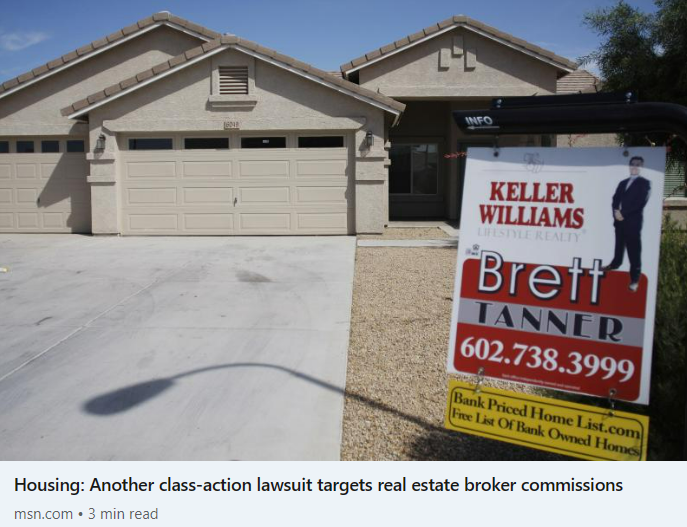What is value? It encompasses both tangible and intangible aspects and can be very subjective but In economics and business, value often refers to the utility, satisfaction, or benefit that a product, service, or asset provides relative to its cost or price. In economics, it can be measured. When using an agent, sellers should understand they are paying for three things and not necessarily what they are told they are paying for:
- Access to the Marketplace: Over the last 100 years the real estate industry has been shaped to create a market run by brokerage companies and Multiple List Services (MLS) owned by brokers. To sell your home and receive visibility, the industry created rules, regulations, and a marketplace exclusively owned by brokers. Even Zillow and other websites that post homes for sale get the vast majority of the data exclusively from MLS systems. It is nothing more than a pay-to-play system if you want to have the maximum visibility for your home. You are paying for access and buyer agents to bring buyers and it doesn’t matter which seller agent you use. About 60% of the commission and fees paid by sellers is nothing more than paying for access. Some would argue that FSBO exists. To that I would just point out that FSBO were 7% of home sales in 2023 according to NAR, half were sold to family, friends, or someone already known to the seller, and much of the rest to investors and not the general public. In my opinion, a 93% market share in any industry would qualify as a captive market.
- Services offered: Services offered by agents can vary tremendously and not all services offered are specifically in the interest of the seller or used for the promotion and marketing of a home. Marketing services that increase the visibility of your home are beneficial, but those that market the agent using your home as a backdrop are not. Taking professional photos, drone videos, 3D tours, video tours, and email/mail marketing to buyer agents and local renters of your home are beneficial as they promote your home and increase visibility. Mailing postcards to your neighbors about your listing not so much (that’s agent self-promotion). Sellers should be paying for services that are directly tied to the marketing and promotion of their home. Services offered by agents account for another 30% of the commission and fees paid by sellers.
- Understanding of the market: A good understanding of the real market is important. Some would equate understanding with experience but in an ever-changing market, using generic forms, and 90% of the transactions are standard it is less important today. 20 years ago it was important as sellers were dependent on the Rolodex kept by experienced agents and brokers to find buyers. It is very important in the very high-end luxury market where connections and networks to high net worth individuals are needed and many listings are off the market. In this specific niche market space, who you know is the most important value. Today, for most homes under 10 million dollars, the marketplace is open to the public and is online.
Understanding the market and buyers (especially their online behavior) is key. For example, an experienced agent (in years on the job) might just take photos and post them on the MLS. An agent who understands the market and buyers would post 3D tours, drone videos, floor plans, and video walkthroughs with the listing as those attract 37% more views, viewers spend 60% more time on the listing, are twice as likely to come to view the home in person, sell 14% faster, and sell for 4.8% more according to data from Matterport and Zillow.
Understanding micro/macro-economic and industry data and current trends to include the psychology of buyers and agents (ie did you know that black or charcoal-painted front door homes sell for more than any other color?) is important to correctly price, market, and promote a home. Understanding of the market Services accounts for another 15% of the commission and fees paid by sellers. The reason it is smaller is that without offering the right services that complement that understanding to bring in buyers and their agents it is ineffective and therefore less important. The right pricing and strategy will be less effective without the right set of services to implement it and attract buyers.
If one uses the above weights and calculates the value an agent brings for a commission of say 5% we would get the following:
- Access to the market weight 60% or 3%
- Services weight 25% or 1.5%
- Understanding the market/ethics weight 15% or .5%
How should seller agents charge for their commissions?
While the real estate industry says listing commissions are negotiable it is interesting to figure out how commissions are set. Since my background is in economics and business, we could look at different pricing strategies and see which one is most used in the industry:
- Value-based pricing: Consists of setting prices according to what consumers think the product is worth. For real estate, based on the Burnett vs NAR, it doesn’t appear that it is value-based as services offered have little impact on commissions.
- Competitive pricing: Consists of setting prices based on what the competition is charging. Again based on Burnett vs NAR, the difference between commissions is negligible at best.
- Price skimming: Consists of setting high prices initially and then lowering them over time. Agents reducing their commissions over time is rarely done if ever. They will lower the price of homes to find demand but not commission.
- Cost-plus pricing: Consists of setting prices based on the cost of production plus a markup. Since real estate commissions are based on a percentage of the value of the home and not cost+ then this is seldom used. A home valued at 500k or 700k would not have much variance in marketing costs.
- Penetration pricing: setting low prices initially to attract customers and then raising them later. An agent that is new or one with 20 years of experience, according to evidence presented in the Burnett vs NAR case, offers little to non-existent variance in commission rate. Not me saying it just what the evidence that was provided in the case.
- Economy pricing: Consists of setting low prices to target price-sensitive customers. Again not something done in the industry much except for budget brokerage firms that list homes for a fixed or low rate but offer little to no services. They put it up on the MLS and then sellers are on their own.
- Price discrimination: Consists of charging different prices to different customers for the same product. This would be illegal in the industry as it is strictly regulated against housing discrimination.
- Price leadership: Consists of setting prices that other competitors follow or match. Again based on Burnett vs NAR, even though NAR does not admit guilt, is the most likely used strategy in the industry. One can only use statistics which happen to show that the vast majority of commissions are between 5% and 6% and on average sellers pay about 5.49% of the home’s sale price on realtor fees, 2.83% going to the seller’s agent and 2.66% going to the buyer’s agent. I am not saying it the data is. People can interpret the data whichever way they want and say or not say what it looks like but one must note that NAR lost a lawsuit based on this exact issue and instead of appealing settled with the help of the DoJ to limit damages (not giving my opinion just stating facts).
- Target pricing: Consists of setting prices based on the expected or desired profit margin. Again since commissions are based on percentages versus costs this is not used in the industry. The objective of the target pricing strategy is to plan, design, and manage costs and then set a target price. But each home is different but statistically the variance between commissions has been small.
- Dynamic pricing: Consists of changing prices according to demand, supply, or other factors. This is to me the most interesting strategy and one that I use but is not standard in the industry.
Out of the many textbook pricing strategies that exist, price leadership seems to be the most used. It makes sense as price leadership occurs when a leading firm in a given industry can exert enough influence in the sector that it can effectively determine the price of goods or services for the entire market. You the reader, could decide to use your imagination and juxtapose the National Association of Realtors which large brokers belong to working with the Multi listing Services owned by large brokers could be seen as exerting influence on prices in a market and see if it fits the definition of price leadership. Not saying that they are colluding or being antitrust but that is for you the reader to determine.
How commissions should be set:
I can’t speak for other agents but can speak of what I do and why. My goal is not just to sell a home but to maximize returns for sellers. That’s the fiduciary duty of agents working for sellers. I understand that “Access to the Marketplace” (60%) is the main value of using an agent and “Services Offered + Understanding of the market” (40%) is how agents differentiate themselves.
I charge for the value of the services I offer and my understanding of the market versus simply access. I discount access to the housing marketplace which is standard for all agents. I offer the most competitive commission rate (Well below 5%-6% commission which is negotiable even if most commissions statistically fall in that range) which can save sellers thousands of dollars in commissions. I also do not charge broker or administrative fees (which could be several hundred dollars and are rising every year). Sellers deserve to keep more of their hard-earned equity gains without sacrificing service and quality instead of paying 60% for access which doesn’t sell a home any better or faster than any other home listed for sale on the MLS.
So again what sells a home better and faster? Marketing! I use the latest marketing tools and techniques to showcase a home in its best light. By understanding the art of storytelling, I ensure that a property’s story is compelling to potential buyers. I don’t just post pictures on the MLS and hope traffic comes but understand how buyers today search for homes online and who/what can influence them and gain their attention. This is why I offer all my listings:
- Unlimited professional Photos
- Matterport 3D tours
- Floor plans
- Drone photography and video
- A professional home video
- Homebuyer sales packet and brochures
- In-home marketing (strategically place QR code information displays, and an Alexa voice device to answer questions)
- Active marketing to local rentals in the target price range
- Active marketing to real estate agents and mortgage lenders
- Social media marketing
- Open houses
- and more
I tailor my commission rates to reflect the intricacies of the market, considering factors such as price point, the condition of the home, and other factors all of which influence the complexity, ease, demand level, and projected time needed for the sale. If a house can sell easily, quickly, and with fewer complications why would a seller pay as much or more as one that is harder, slower, and more complicated? If my job is made easier because the seller did a great job of buying a good property, making beautiful renovations and updates, took the time and energy to maintain it well then why should the seller be penalized for doing the right thing or better why are they not rewarded?
When looking at how to price my services here are some key criteria I consider in determining commission:
- Buyer Demand and Affordability: The level of demand at the home’s price point directly impacts the discount offered. Higher demand translates to a larger discount.
- Investor Demand: Similar to buyer demand, investor interest plays a role in commission rates. Greater investor demand results in a larger discount.
- Neighborhood Supply: The current supply of homes in the neighborhood influences the discount offered. A smaller supply correlates with a larger discount.
- Home Condition: The condition of the home in relation to its price point and demand affects the discount. Higher demand for homes in good condition leads to a larger discount.
- Updates/Renovations/Major ticket items: Homes with recent updates, particularly in key areas like the kitchen and bathrooms, as well as recently replaced major items like the roof and HVAC system, receive a larger discount. The more extensive the upgrades and the newer the big-ticket items are, the greater the discount offered. It stands to reason that when a home occupies a coveted price bracket, resides in an excellent neighborhood, boasts impeccable condition, and flaunts numerous updates and renovations, has little competition, the sale process becomes swifter and smoother.
Consequently, the seller ought to be entitled to a more substantial commission discount. Conversely, for properties entailing greater complexity, facing prolonged duration on the market, and demanding extensive marketing efforts, the discount should be proportionately smaller. Such an arrangement fosters fairness and equity in the transaction and is of course negotiated.
Sellers have been getting the wrong end of the stick for years. They shouldn’t be paying more in commissions and they should have commissions based on the level of difficulty of the sale and marketing effort and not based on the statistical median commissions heavily skewed to the right of a skinny bell curve which could or could not be evidence of antitrust because commissions are negotiable.







